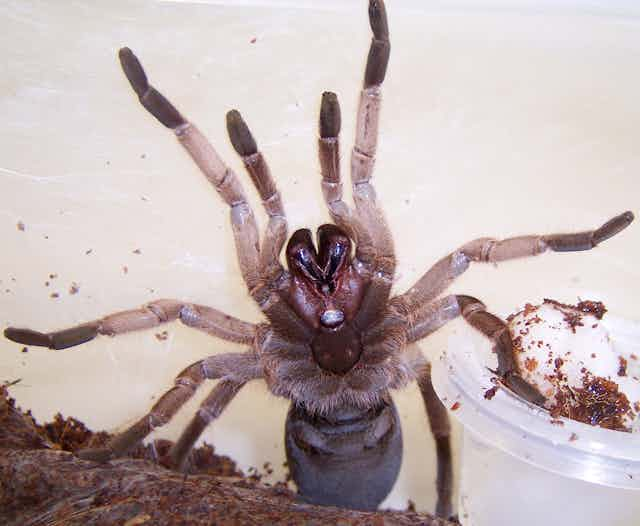Insecticide resistance is the quieter, lesser-known relative of antibiotic resistance. Anyone who has been to a hospital recently knows about antibiotic resistant bacteria. But how many people think about insecticide resistance when they spray their home garden with insecticides?
Today, in the journal PLOS ONE, our research group has published the first directed-discovery research program for a new, environmentally-friendly insecticide from the venom of a native Australian tarantula.
Although it is no surprise that spider venoms kill insects, this work is particularly exciting because it is the first time scientists have done oral screens to find new insecticidal venom components.
There are three main benefits for our venom-based insecticide:
- High efficacy, particularly with insects that are resistant to conventional insecticides.
- The oral activity of the compound (rather than contact or systemic toxicity of most conventional insecticides).
- The ability to inexpensively produce OAIP-1.
A potent molecule
Current insecticides mostly use one of three molecular targets to kill insects:

Acetylcholinesterase, an enzyme involved with neurotransmitters, makes up 46% of resistant insect species and 45% of the active ingredients (AIs) available that insects have developed resistance against.
Chloride channels (19% of resistant species and 6% of resistant AIs) and sodium channels (24% of resistant species and 14% of resistant AIs) are the other two most common molecular targets of insecticides, and both are involved in the insect nervous system.
Our paper describes one of the orally active insecticidal peptides (OAIPs) we discovered.
We solved the structure of this peptide using nuclear magnetic resonance (NMR), which is like Magnetic Resonance Imaging (MRI) for small molecules. This means we know what OAIP-1 looks like and can use that information to help find out how the molecule works.
The molecule, OAIP-1, was also tested for insecticidal activity and we found it to be the most potent insecticidal venom peptide to date. The molecule is also more active against economically important pests, including the cotton bollworm (Helicoverpa armigera), than conventional insecticides.
Perhaps most importantly, OAIP-1 is synergistic with imidacloprid, a currently available insecticide. By using our OAIPs in tandem with existing insecticides, we will be able to better control insect pests. This will be an especially effective approach for insects that are already resistant to conventional insecticides.
Targeting the bad guys
Determining the degree of interaction with non-target organisms will be an important next step for our work. Minimised toxicity to beneficial insects has become an important feature of any new insecticide. These insects include pollinators (such as bees) and predators (such as ladybugs).

Because our compound is orally active, rather than a contact insecticide, we expect non-target insects will be less affected by our OAIPs than they are by conventional insecticides. Advanced formulation and the use of baits and attractants will also help minimise the total amount of OAIP-1 that needs to be used.
Previously published neurotoxic insecticidal peptides have been shown to be lethal to insects but safe for vertebrates. This is because the nervous system of insects and vertebrates is very different, and as a result those compounds that act on insects are relatively harmless in humans and other mammals.
Mass production
Tarantulas live for five to ten years or more, but their venom is so potent we only need small amounts to begin our discovery program.

For future experiments and commercial products, OAIPs will be produced recombinantly in yeast by integrating DNA into the yeast genome.
Many human pharmaceuticals are regularly produced this way, including hirudin (an anticoagulant) and human insulin. Production in yeast is safe, cost effective, and can be carefully monitored.
We have discovered an effective, selective insecticide that can be produced on an industrial scale at an affordable price.
Given the scarcity of pest management products that have been developed entirely within Australia, our goal is to provide an Australian solution for a global problem.

